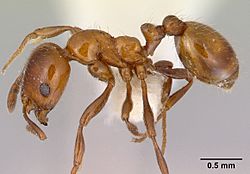Monomorium antarcticum facts for kids
Quick facts for kids Monomorium antarcticum |
|
|---|---|
 |
|
| Scientific classification | |
| Kingdom: | |
| Phylum: | |
| Class: | |
| Order: | |
| Family: | |
| Subfamily: |
Myrmicinae
|
| Tribe: |
Solenopsidini
|
| Genus: |
Monomorium
|
| Species: |
M. antarcticum
|
| Binomial name | |
| Monomorium antarcticum (F. Smith, 1858)
|
|
The southern ant (Monomorium antarcticum) is a tiny insect that belongs to the ant family, Formicidae. This special ant lives only in New Zealand, meaning it is endemic there. It's probably the most common native ant you'll find in New Zealand!
Southern ants can look quite different from each other. They vary in size, from 3 to 5 millimeters long. Their color can also change a lot, from orange to dark brown or even black. Because they are so varied, scientists think that Monomorium antarcticum might actually be a group of very similar ant species.
These ants are not picky eaters. They have a "generalist diet," which means they eat many different things. This includes small bugs, sweet nectar from plants, and seeds. They also like a sugary liquid called honeydew. They get honeydew from tiny insects like aphids, scale insects, and mealybugs, which they "farm" or tend to.
Where Southern Ants Live
Monomorium antarcticum is found only in New Zealand. You can spot them all over the North and South Islands. They also live on smaller islands nearby, like Stewart Island, the Three Kings Islands, the Chatham Islands, the Kermandec Islands, and the Austral Islands.
These ants are very adaptable and can live in many different places. Their homes include native forests, open grasslands, and wet areas like wetlands. You can also find them in farmlands, gardens, and even in areas where people work or grow plants.
However, in some cities, especially in northern New Zealand, southern ants might have trouble. They sometimes face competition from other ant species that are not native to New Zealand. These "exotic" ants can make it harder for the southern ant to thrive in urban areas.
How to Identify a Southern Ant
It can be tricky to identify a southern ant because they look so different! Worker ants, which are the ones you usually see, are typically 3 to 5 millimeters long. Their heads are usually between 0.60 and 0.88 millimeters wide.
Here are some features to look for:
- Antennae: They have 12 segments on their antennae, with the last three segments forming a thicker "club."
- Body Shape: There's a groove on their back called the metanotal groove. It can be very clear or just a faint line.
- Spines: On a part of their body called the propodeum, they might have blunt spines, or sometimes no spines at all.
- Color: The color varies a lot between different ant colonies. Some colonies are orange, others are light brown, dark brown, or even black. But usually, all the ants within one colony will be the same color.

